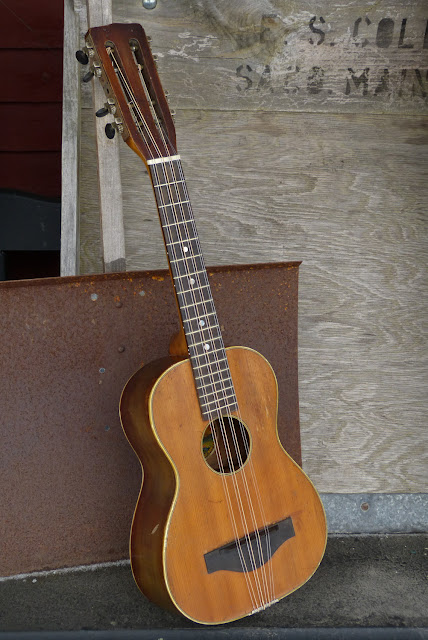1920s Harmony-made Bruno Tiple
I've worked on a number of these Harmony-made, Bruno-branded tiples (often with the Maxitone label tacked to the headstock) and I've come to conclude that most vintage tiples (aside from the Martin variety) can sound absolutely wonderful but have design flaws which, if I have my way, are easily addressed and turn ho-hum instruments into excellent -- and practical -- ones. What's a tiple? Regular readers will know, but in short in North America they're steel-strung, 10-string, octave-ful, tenor-uke-sized instruments and are either tuned ADF#B (traditional) or GCEA (much more practical) -- which means you can borrow all the uke fingering but need to rethink your style.
Work on this one included a neck reset, fret level/dress, mod to the tuners to reduce the count to 8 instead of 10, a new ebony bridge with mando-style "floating saddle," vintage tailpiece addition, a number of hairline crack cleating/sealing jobs (two on the back, two on the top), a new nut, and setup. It's strung-up as normal (GCEA with octaves on the lower 3 strings) but is missing the extra octave string on both middle courses compared to a "normal" tiple setup. This is how I keep my own tiple strung and the reduced count allows for slightly-heavier wound strings (for better tone) and an easier time tuning and playing it.
The neck is straight and has a 1 1/2" nut width and a medium, rounded C-shape to its profile (comfy for a tiple). Action is spot-on at 1/16" overall at the 12th fret. The sound is like you'd expect -- a "mini 12-string" vibe but more open and punchy than a "pin bridge" string load while still having the darker, sweeter sound that I expect from Harmony tiples (vs. the concurrent zippy Latin sound of Regals or the absolute mellow of Oscar Schmidt products).
Work on this one included a neck reset, fret level/dress, mod to the tuners to reduce the count to 8 instead of 10, a new ebony bridge with mando-style "floating saddle," vintage tailpiece addition, a number of hairline crack cleating/sealing jobs (two on the back, two on the top), a new nut, and setup. It's strung-up as normal (GCEA with octaves on the lower 3 strings) but is missing the extra octave string on both middle courses compared to a "normal" tiple setup. This is how I keep my own tiple strung and the reduced count allows for slightly-heavier wound strings (for better tone) and an easier time tuning and playing it.
The neck is straight and has a 1 1/2" nut width and a medium, rounded C-shape to its profile (comfy for a tiple). Action is spot-on at 1/16" overall at the 12th fret. The sound is like you'd expect -- a "mini 12-string" vibe but more open and punchy than a "pin bridge" string load while still having the darker, sweeter sound that I expect from Harmony tiples (vs. the concurrent zippy Latin sound of Regals or the absolute mellow of Oscar Schmidt products).
The top is solid spruce while the back and sides are solid birch. I'm pretty sure the neck is poplar and the fretboard is stained mystery-wood (maple? pearwood?). My new bridge replacement is thin ebony and the floating ebony bridge upon it is a repurposed (and compensated) 1920s mandolin bridge.
It's got good back-angle on the bridge, too, for a clean sound.
While it's hard to see in the photo, the original "tie block" or "pin-style" bridge is split behind its "tie block" area. This is super common as the sideways tension with 10 strings is pretty intense. I find that the glued, pin-style tiple bridges on Chicago-made instruments offer a very mellow tone but they also "choke" the instrument a heck of a lot because of the way the tension wants to "curl" the top. Once you free these up with a tailpiece load they sound awesome.
I would have made use of the original bridge (and its "tie block" area) in the same way they're handled on bandurrias, but because it was damaged I went with the "mandolin approach."
At least the missing tuner on each side makes it clear which patch of strings you're tuning!
I forgot to mention that I added side dots and replaced 3 missing pearl dots.
String gauges are 10/22w G, 16/38w C, 14/30w E, 9/9 A. This has a 17" scale length.
The top shows some wear-and-tear from picking to the treble side of the fretboard and soundhole, but is otherwise in good shape. The three hairline cracks extant on it are very tight (and hard to see in the photos), though I've added cleats where I thought necessary.
The top and back are both bound in white celluloid. There's a longer, filled/cleated crack on the back on the lower bout and one smaller hairline at the upper bout.
Note how Harmony put two sets of cut-down tuners together to get the full 10 on this instrument. Either it was parts-bin fishing day or they couldn't get a supplier for a while when this one was made!
The tailpiece is "standard issue" mandolin stock from the period. I have half a dozen of these hanging-out in my bins.
As I stated before -- usually this Bruno mark is in conjunction with a "Maxitone" tacked-on label at the headstock. In fact, this instrument has two pinholes in the headstock where that label would've sat at one point!
There's also a label in the soundhole with enough bits left to note that this was originally sold by a Providence, RI music shop.






















Comments